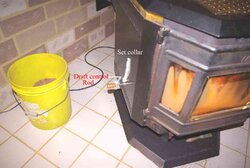Newbie here but I have been reading the posts for a while and find them very informative. I have a Whitfield Advantage pellet stove manufactured in 1993. It has worked well for us for 3 seasons (it came with the house we bought) but now has developed a problem with the burn pot filling with pellets after about an hour. I replaced the gasket in the door and have opened the damper all the way to try to get maximum air in since everything I've read about this points to a lack of combustion air. I have also considered a feed rate problem--is there a way to adjust it. Our control board is basic--one knob for heat output (1 to 5), one knob for the room air fan, a red button to begin the process (turn blowers on) and another switch for the auger to feed.
I am cautious about sinking too much money into this thing since it is 17+ years old. It may have just reached the end of its life. Is there anything else I can do other than that which I have done (cleaned everything, opened damper, cleaned again, replaced gasket, cleaned again). The fans are working (seemingly fine) and the vent was cleaned as well.
I'm considering a Bosca Spirit 500 found on ebay for a very decent price (under 2k with shipping) as a replacement. Are there any other stoves worth looking at that are less than $2200? FYI I have about 1500 sqft of house, rancher style. Thanks in advance to your replies and advice.
Semper Fi
I am cautious about sinking too much money into this thing since it is 17+ years old. It may have just reached the end of its life. Is there anything else I can do other than that which I have done (cleaned everything, opened damper, cleaned again, replaced gasket, cleaned again). The fans are working (seemingly fine) and the vent was cleaned as well.
I'm considering a Bosca Spirit 500 found on ebay for a very decent price (under 2k with shipping) as a replacement. Are there any other stoves worth looking at that are less than $2200? FYI I have about 1500 sqft of house, rancher style. Thanks in advance to your replies and advice.
Semper Fi



